Purchasing a guitar system is not something you do every day. So, there are some things you need to know and consider when doing it. In this article, we’ll guide you through the process and help you find the right system for you.
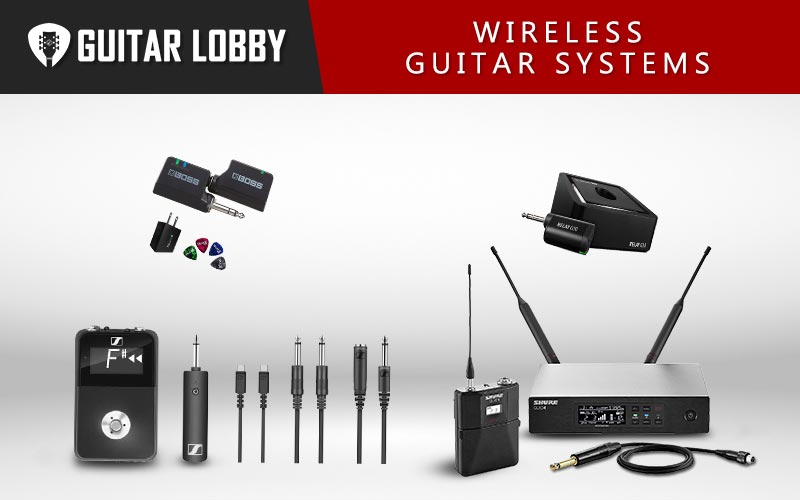
We’ll start this article by jumping straight into reviews on the best wireless guitar system at each price point, but if you want to learn more before reading reviews, we have put together an in-depth buying guide at the bottom of the page here.
| Name of Product | Image of Product | Description | Price Range | Full Review |
|---|---|---|---|---|
| 1. Shure GLXD14R (Best Overall) | 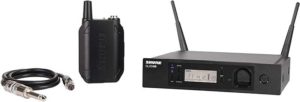 | Range: 200 ft Battery: 16 hours | $550 | Read Full Review Below |
| 2. Line 6 Relay G10S Digital Wireless Guitar System (Editor's Choice) | 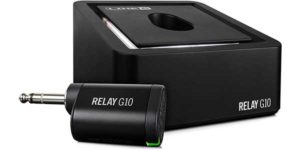 | Range: 130 ft Battery: 6 hours | $250 | Read Full Review Below |
| 3. Boss WL-20 Digital Wireless Guitar System (Best Value) | 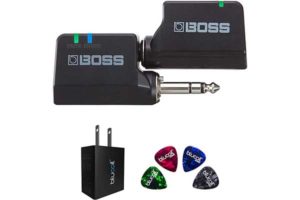 | Range: 50 ft Battery: 10-12 hours | $200 | Read Full Review Below |
| 4. Xvive Audio U2 Digital Wireless Guitar System (Budget Pick) | 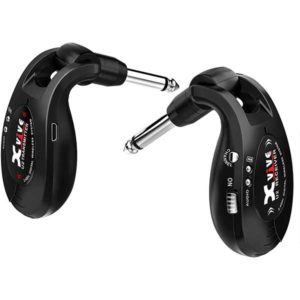 | Range: 100 ft Battery: 5 hours | $155 | Read Full Review Below |
| 5. Shure PGXD14 Digital Wireless Guitar System | 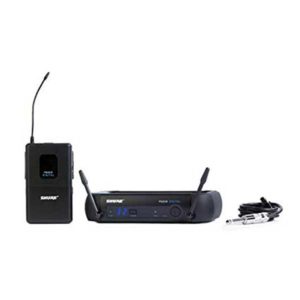 | Range: 200 feet Battery: 10 hours | $350 | Read Full Review Below |
| 6. Boss WL-50 Guitar Wireless System | 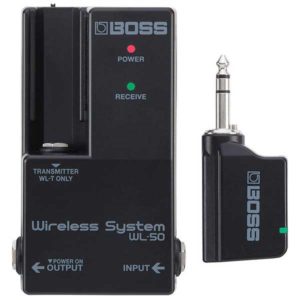 | Range: 65 ft Battery: 12 hours | $220 | Read Full Review Below |
| 7. Samson AirLine 88x Guitar Wireless System | 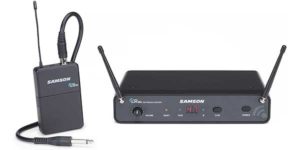 | Range: 300 ft Battery: 5 hours | $200 | Read Full Review Below |
| 8. Shure QLXD14 G50 Band | 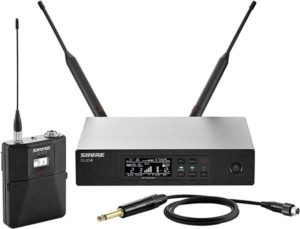 | Range: 300 ft Battery: 9 hours | $875 | Read Full Review Below |
| 9. Nady U-1100 GT | 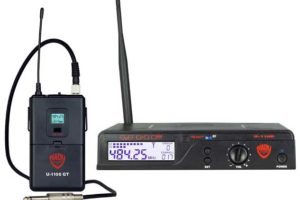 | Range: 500 ft Battery: 8-10 hours | $120 | Read Full Review Below |
| 10. Sennheiser XSW-D Pedalboard Set | 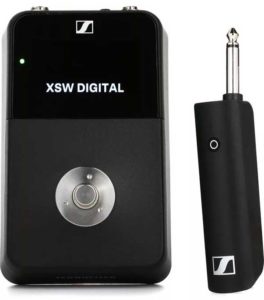 | Range: 250 ft Battery: 5 hours | $350 | Read Full Review Below |
| 11. Getaria GWS-8 | 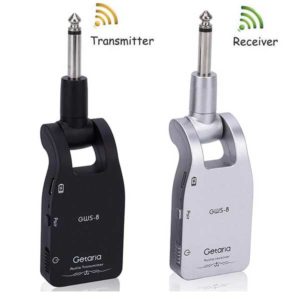 | Range: 100 ft Battery: 1 hour | $40 | Read Full Review Below |
| 12. LEKATO 5.8GHz Wireless Guitar System | 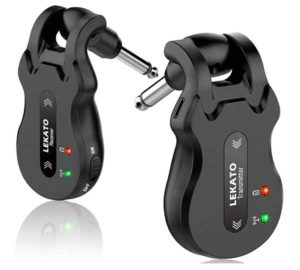 | Range: 300 ft Battery: 5 hours | $70 | Read Full Review Below |
| 13. Getaria GWS-26 | 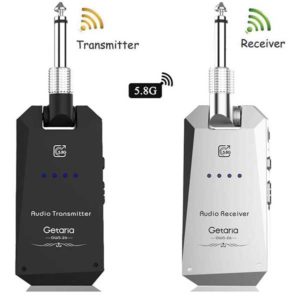 | Range: 100 ft Battery: 8 hours | $65 | Read Full Review Below |
| 14. Nady DKW-3 GT | 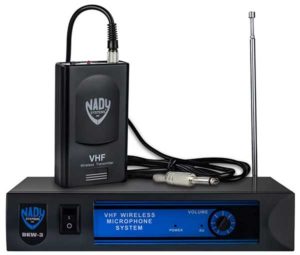 | Range: 300 ft Battery: 15 hours | $60 | Read Full Review Below |
Here Are the Best Wireless Guitar Systems on the Market
1. Shure GLXD14R (Best Overall)
| Estimated Price | $550 |
| Range | 200 feet |
| Battery Life | 16 hours |
My Review: Shure GLXD14R features the advanced digital wireless platform, which is a complete upgrade from the older version of the GLX-D line because it comes with the most modern receivers, alongside the integration of frequency management. This model comes with a GLXD1 bodypack transmitter, combined with the excellent WA302 guitar cable from Shure. As for the power supply, the transmitter comes with a rechargeable Lithium-ion battery, which can be recharged very fast. Along with that, you can also get a USN cable for battery charging, as well as the padded accessory case with a zipper. When it comes to the receiver, this model features a GLXD4R rackmount receiver, which has the combination of LINKFREQ frequency that is automatically managed, and the painless automatic configuration. Along with that, there is an option to link up to 6 different systems via the multichannel setup, which is allowed by the GLX-D advanced frequency manager, as well as through the use of the distribution module.
Key Specs and Features: This one features a globally unlicensed 2.4 GHz frequency band, allowing the simultaneous operation of mostly 9-11 channels, with constant bi-directional communication that exists between the transmitter and receiver, allowing them to sync faster. There is a lithium-ion rechargeable battery that allows you to work continuously for about 16 hours straight, in a medium transition range of about 200 feet. With the integration option for 6 other GLX-D Advanced systems, through the single-use of Frequency Manager, as well as LINKFREQ intelligent frequency management, you will be able to find the best available channels. There is constant monitoring for potential interference, as well as the automatic frequency change, for you to remove any type of interruptions in the signal, and you can further improve capabilities for transmission of the signal through the antennas.
Build Materials: Shure GLXD14R is relatively well-made, mostly from the top-notch ABS plastic, which gives it a pleasing aesthetic look, as well as pretty good durability.
Hardware: This digital system with a frequency range of 2.4GHz, which allows 9-11 simultaneous channels, and the maximum transmission range inside is 200 feet line of sight in ideal conditions, but it is mostly 100 feet. The maximum transmission range outside is 165 feet in perfect conditions, while the most common being 65 feet line of sight. Channel selection can be done both manually and automatically, and there are two instrument cable connectors: 0.25” and TA4F. Moreover, it has a bodypack transmitter with a dynamic range of 120dB, 1 x TA4M transmitter connector, and the 3.7V SB902 rechargeable Li-ion battery, which lasts up to 16 hours straight. Finally, there is a rackmount receiver with half-rack spaces and three outputs: 1x XLR, 1 x 0.25”, 1 x USB-Micro B, detachable antenna, and LCD front display on the receiver.
Finish: Black ABS plastic with a boxy shape looks pretty good on the GLXD14R model, which alongside a nice LCD display, and carefully arranged buttons gives it an even better look.
Who Will Use This the Most: GLXD14R wireless guitar system from Shure is definitely one of the most searched systems by professionals, however, the price point isn’t nearly as low as most other systems on this list. Therefore, it is perfect for performers who need to achieve the highest quality signal.
Bottom Line: Shure GLXD14R is arguably the best wireless guitar system available.
2. Line 6 Relay G10S Digital Wireless Guitar System (Editor’s Choice)
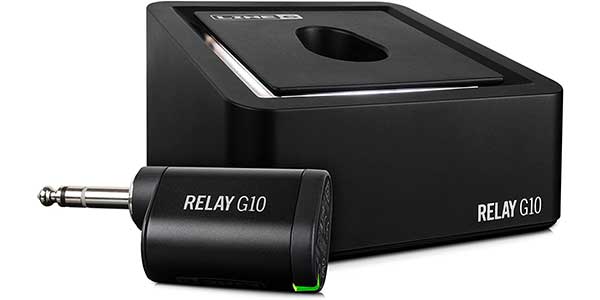
| Estimated Price | $250 |
| Range | 130 feet |
| Battery Life | 6 hours |
My Review: If you are looking for the best of the best when it comes to wireless guitar systems, then look no further than the Line 6 Relay G10S. It is a perfect choice for guitar, as well as bass as it has a really high impedance output. This wireless guitar system allows you to move freely across the stage since its effective range is 130 feet. G10S comes with 24-bit audio that is completely frequency-agile, as well as multiple-redundant. With the XLR direct output, you will be able to create awesome tones wherever you want. You can select the frequency both manually and automatically, which allows you to have various different setups. It features pretty useful LED indicators for the wireless signal, as well as for the level of the battery, which will help you figure out when the device needs to be recharged. As for the battery itself, this guitar wireless system comes with a Li-ion battery that can last around 6 hours of non-stop work. Additionally, there is a Cable Tone switch option, allowing you to emulate multiple tones of 10 and 30-foot cables, without having to use the cable itself.
Key Specs and Features: It’s a very reliable device, allowing you to create wonderful sounds because of its digital wireless system, with an excellent range of 130 feet. It has an automatic setup, for easy use, while the frequency can also be selected manually if you want to use some specific channels. The battery can sustain 6 hours of constant work, with the LED indicators for wireless signal and battery level. Furthermore, it’s capable of providing a very dynamic, quite reliable, and perfectly clear transmission with the redundant 24-bit digital wireless tech. It allows you to get your tones wherever you want with the XLR direct out, and with the Cable Tone switch, you can have the tones the same as if you used 10 and 30-feet cables.
Build Materials: Line 6 Relay G10S is made of high-quality materials, with a base that is made of top-notch ABS plastics, which helps the device to last longer.
Hardware: It offers a digital wireless instrument system, with 10 simultaneous channels, a 2.4GHz range of frequency, and an effective range of 130 feet. Moreover, it gives both automatic and manual selection, along with the frequency response range between 10Hz-20kHz. There is a plug-in form factor and with the transmitter’s dynamic range of more than 110dB, and one 0.25” cable connector slot. And it comes with a built-in rechargeable Li-ion battery that can last up to 6 hours of continuous play Finally, it features a fixed antenna pedal receiver, an LED display, and two receiver outputs, one XLR, and one 0.25”.
Finish: Line 6 Relay G10S model looks pretty neat, with the LED lights indicating the available battery level, as well as the wireless signal. Along with that comes the channel wheel, allowing you to set the automatic channel, or to select it manually. With a nicely placed logo and model information on the top, this wireless guitar system comes with really classy looks.
Who Will Use This the Most: Due to the number of available options, Line 6 Relay G10S is perfect for live performers, who need to move a lot around the stage. However, since it is also very easy to set up, it can be used by less experienced people, who simply want to enhance their guitar tones.
Bottom Line: Line 6 Relay G10S is a very reliable, durable, and effective wireless guitar system that will completely eliminate your need for using cords during your performances, while also letting you keep the high-quality sound.
3. Boss WL-20 Digital Wireless Guitar System (Best Value)
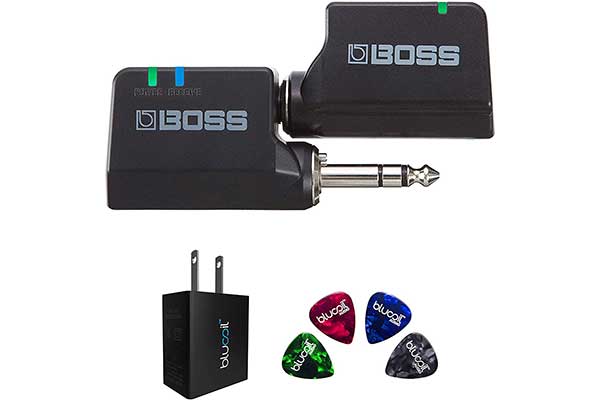
| Estimated Price | $200 |
| Range | 50 feet |
| Battery Life | 10-12 hours |
My Review: Boss WL-20 is very simple to use, and yet, it is a highly effective wireless system that will completely eliminate your need for cords, since it features quite easy to use plug and play design. Along with that comes ultra-low latency, as well as the option to experience expansive dynamics, while maintaining excellent stability at a maximum range of 50 feet. Also, you won’t have to worry about not losing the cable tone quality, since this wireless guitar system includes a cable tone simulation option, allowing you to relive the natural sound of a 10-foot cable. This will also allow you to experience a bit of a treble, just like it would be possible if you used the cable connection instead, which is perfect for guitars and basses. Apart from that, this device comes with a Lithium-ion rechargeable battery, which can last up to 10-12 hours of constant music-making, before having to recharge. Charging is also quite simple since you will get a 5V/500mA USB adapter, which you can use to charge both transmitter and receiver at the same time, with the option to charge them separately with the micro USB cable.
Key Specs and Features: This system features easy to use plug and play design, with the cable tone emulator, to let you experience the natural sounds of a 10-foot cable, for up to 10 hours straight on a single charge, thanks to the long-lasting Li-ion battery. Latency is ultra-low, while dynamics are quite expansive, which is perfect for guitars and instruments that feature passive pickups. It allows you to use 14 different Boss wireless systems at the same time at the maximum working range of 50 feet, without losing any stability. Moreover, it comes with the standard USB adapter for a simple recharging process, as well as with a Micro USB cable included if you want to charge the receiver or transmitter separately.
Build Materials: One of the best things about Boss is that it always offers products made of top-quality materials, which is the case with the WL-20 as well since it is made of the best ABS plastic.
Hardware: This one offers a digital system with the 2.4 GHz frequency range, which allows up to 14 simultaneous channels at the maximum operating range is 50 feet, with the need for a line of sight. The frequency response is in the range of 20Hz-20kHz, and the dynamic range of the transmitter is more than 110dB. Furthermore, it features the Li-ion rechargeable battery, which can last between 10-12 hours of continuous work. The transmitter connector is 0.25”, and there is a combination plug receiver with the 0.25” output and the same size as the transmitter.
Finish: Boss WL-20 Digital wireless guitar system is beautifully crafted with the logo and logotype being on the side, under the LED indicators on both transmitter and receiver. It’s really compact to use, which is perfect if you need to travel a lot and carry it with you.
Who Will Use This the Most: Because of the relatively easy to use plug and play design, this device is perfect for beginners, as well as professionals who want to tune up their guitar sound to the optimal level.
Bottom Line: Even though it features a shorter operating range than some other wireless guitar systems, Boss WL-20 is still a great choice for everyone who is looking for a reliable and stable system.
4. Xvive Audio U2 Digital Wireless Guitar System (Budget Pick)
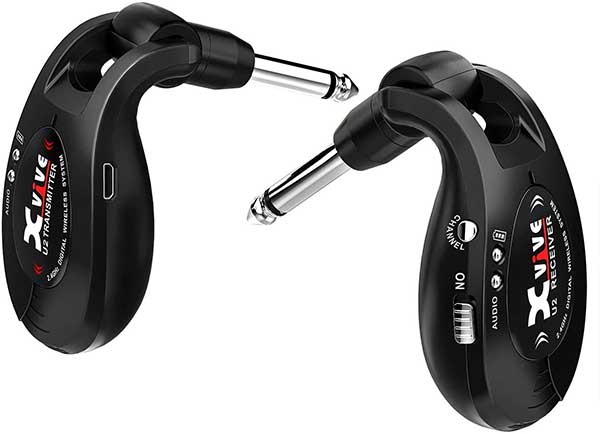
| Estimated Price | $155 |
| Range | 100 feet |
| Battery Life | 5 hours |
My Review: The Xvive U2 has been one of my favorite wireless systems for a long time. It is very easy to use and is very reliable, which makes it perfect for both pro players and beginners alike. It has a stable frequency response of 20Hz-20kHz, as well as the 2.4 GHz ISM band, which provides a strong signal for optimal performance and I’ve never experienced any dropouts while using this system. It is also very compact and has a low latency of 6ms. It features rechargeable Lithium-ion batteries that last about 5 hours on a single charge. The transmitter and receiver are made of high-quality and durable ABS plastic.
Key Specs and Features: The digital wireless signal transmitter with a 2.4GHz frequency and 24-bit/48kHz uncompressed conversion allow for good signal strength within its 100 feet range, allowing you to move freely during your performances. Moreover, it is simple to install and use since it comes with a USB split cable that is capable of charging both batteries at the same time. It is extremely compact and with this system, you’ll never have to worry about wires.
Build Materials: I really like the build quality of the transmitter and receiver. Both are made of quality ABS plastic, which is likely a primary reason why this system is known to last a long time and be very durable.
Hardware: The system features passive pickups and a frequency range of 2.4GHz, as well as the ability to use 4 simultaneous channels across the operating range of 100 feet. It has auto channel selection and a dynamic range of 103dB. Additionally, it has a plug-on form transmitter and receiver with a lithium-ion rechargeable battery with a life span of 5 hours.
Finish: This wireless guitar system looks quite nice and classy, with the manufacturer’s name and sign in the middle, along with the model below it. All slots where you can plug guitar or bass are easy to spot since they are marked with clear indicators, such as for audio, for instance.
Who Will Use This the Most: Xvive U2 model is so easy to set up and use that it can be used by almost everyone, from professional performers, who need to be able to move around the stage, to the casual players, who simply need some time to learn how to play guitar.
Bottom Line: Xvive U2 model is a very affordable piece with excellent characteristics, and solid performance, for both casuals and professional players. This is simply one of the best wireless guitar systems out there for the money.
5. Shure PGXD14 Digital Wireless Guitar System
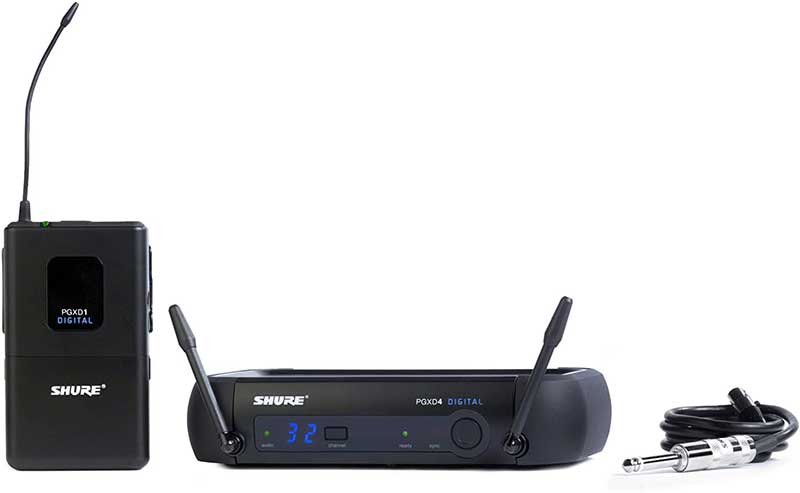
| Estimated Price | $350 |
| Range | 200 feet |
| Battery Life | 8-10 hours |
My Review: This wireless guitar system features excellent reliability, as well as great 24-bit/48kHz sound quality, due to the combination of PGXD1 bodypack transmitter and PGXD4 receiver, allowing you to experience the best possible audio. PGXD1 transmitter is great because it provides top-notch protection against external feedback, while also being able to maintain the highest quality of the tone effects. Along with that come the dual antennas, which increase the stability of the product, allowing great diversity when it comes to reception. Apart from that, there is a one-touch scanning option, which allows you to find the best possible frequency, with the perfect connection, in an instant. This excellent connectivity that exists between the receiver and transmitter is what makes this device capable to deliver the sound quality for which Shure is so famous.
Key Specs and Features: This one has a PGXD1 Bodypack transmitter with the belt clip, as well as LED indicators for the battery life, mute option, and power, for easier recognition. The maximum range is 200 feet or 60m, so you will have enough space to maneuver, and both transmitter and receiver can be connected with the one-touch sync. It offers up to 10 hours of constant work with the AA batteries that come in the package, and the wireless signal is completely reliable and allows digital diversity. The interface can be locked, to avoid accidental change of the already set changes, while the frequency can be selected automatically, in order to find a completely clean channel in an instant, and this device allows 10 compatible channels per frequency. The carrying case also comes in the package, to provide extra protection and transport options.
Build Materials: PGXD14 model is made of the best ABS materials, to provide excellent durability, and ensure that components are safe.
Hardware: Nevertheless, it has digital wireless transmission, with a max wireless operating range of 200 feet (60m), however, a microphone is not included. The frequency response of 20Hz-20kHz allows up to 12 simultaneous systems to be used. It comes with 2 AA batteries allowing you to continuously work for 8-10 hours straight. The receiver has a LED display with 2 removable antennas, with a frequency range of 900MHz, two cable connectors: 0.25” and TA4F, and a dynamic range of 108dB.
Finish: PGXD14 model from Shure looks very stylish, with a nice blue LED display, as well as nicely-shaped components.
Who Will Use This the Most: This model is very useful to professional performers, who want to squeeze every last drop from their wireless guitar system while maintaining the sound quality, and device durability.
Bottom Line: Shure PGXD14 is definitely one of the most interesting wireless guitar systems, capable of delivering high-quality tones and allowing you to quickly find and select the most appropriate frequency for the given moment, without being too demanding.
6. Boss WL-50 Guitar Wireless System
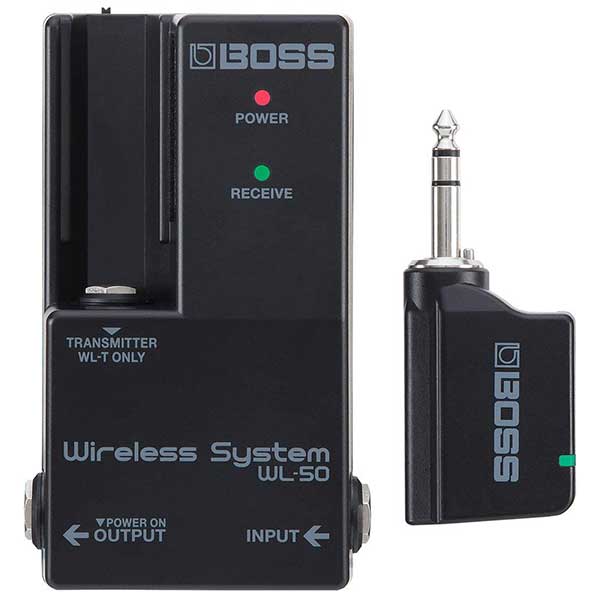
| Estimated Price | $220 |
| Range | 65 feet |
| Battery Life | 12 hours |
My Review: Boss WL-50 model is a pedalboard-friendly completely wireless guitar system that is extremely easy to set up since it features a plug and play design. It will completely eliminate your desire to use cable systems, since it offers excellent sound quality, due to the ultra-low latency, and pretty expansive dynamics. Along with that, this system offers relatively stable performance, even at the maximum operating range of 65 feet, which is not much, but it is still enough if you don’t move a lot while playing. For those who worry about whether they will lose the cable tone quality if they choose to use this wireless system, you won’t have to worry about that. WL-50 comes with two cable emulations, which can completely emulate the audio quality your guitar had with the cable connection. Apart from that, it is quite simple to recharge, since you only need to join the transmitter and receiver, without any extra steps. The receiver can also be charged on its own, via the micro USB cable, which is not provided in the package, by the way. As for the power supply itself, this device can be powered with AA batteries, as well as with a PSA-series adapter.
Key Specs and Features: The size of the receiver is one of the stompboxes, and it comes with a built-In transmitter dock, as well as a simple plug-and-play design, for those who are lazy to setup complicated guitar systems. It has ultra-low latency, alongside the pretty expansive dynamics, while maintaining stability even at a max range of 65 feet It features two cable tone emulators, for recreating the natural sound effect from the cable connection, while batteries allow up to 12 hours of continuous play. On top of it, it’s easy to charge. Simply put the transmitter on the receiver dock, while also being capable of using 14 Boss wireless systems in one spot, and with the DC output for pedals, if you need to connect the device to one or more guitar pedals.
Build Materials: This wireless guitar system is made of pretty good ABS plastic materials, which means that it is very durable, so you won’t have to worry about replacing it every so often.
Hardware: It allows up to 14 simultaneous channels, alongside the digital system with a frequency range of 2.4GHz, and line of sight operating range of 65 feet, combined with 20Hz-20kHz frequency response. There is a form factor combination plug transmitter with a dynamic range of over 110dB, as well as a solid Li-ion battery that can last up to 12 hours straight. When it comes to transmitters, it has a 0.25” transmitter connector and 0.25” receiver output, along with the 0.25” line input and 0.25” transmitter input for the receiver. Finally, it has a pedal type receiver with a weight of 0.5lbs, and 9V DC in/out the power supply.
Finish: WL-50 from Boss looks pretty decent and compact. Every option is marked, so you can never miss the input or output slots. And with the led indicators for power, receive signal, and transmitter status, this device looks even more elegant.
Who Will Use This the Most: Due to the limited range of only 65 feet, WL-50 is the most suitable for musicians who prefer performing in one place, or in close proximity, while also being able to use the pedal system.
Bottom Line: Boss WL-50 model is definitely one of the top-notch wireless guitar systems because it is capable of delivering excellent audio quality with a low amount of effort, but with a quite limited line of sight range.
7. Samson AirLine 88x Guitar Wireless System
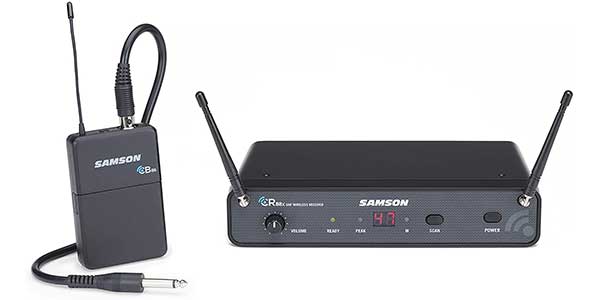
| Estimated Price | $200 |
| Range | 300 feet |
| Battery Life | 5 hours |
My Review: The original version of this model is from the ‘80s, which might turn down a lot of people, even though it really shouldn’t. The 88x version is completely reworked, and now it features automatic frequency scanning, which, alongside the frequency-agile UHF system allows this device to have the maximum operating range of 300 feet, which is completely insane. Along with that, this wireless guitar system comes with fast-paced transients, as well as, pretty strong, but still stable bass notes. You can also notice that the treble end keeps the quality the further you are from the source, which maintains the overall audio quality. What’s the most interesting is that this wireless guitar system has a built-in micro transmitter directly in the plug, which means that there is no need for a belt pack or even cable. Another feature that is very specific for the Samson AirLine 88x is that it has a pivoting jack plug, meaning that you can use it with most other types of jacks. This model works on 16 different channels and comes with the True Diversity technology, which is used to stop random dropouts from happening, as well as with the tone key option, which allows you to decrease the external interference.
Key Specs and Features: It gives a pretty long line of sight operating range of 300 feet, which makes this device perfect for large performances. There is an AirLine 88x receiver with 16 frequency channels you can select, along with the built-in transmitter in the jack plug, which removes the need for a cable or belt pack. It comes with the receiver rackmount kit, and infrared sync between receiver and transmitter for simple setup, alongside balanced XLR output, as well as unbalanced 0.25” output, for combined use with the guitar amps or PA systems. It allows multiple AirLine 88x systems to share the same frequency, up to 8 of them, as well as true Diversity and tone key, which will stop random dropouts and interferences from happening Featuring mute button allows you to avoid having noisy guitar swaps, while the frequency is scanned automatically to make setting up the device easier.
Build Materials: Samson AirLine 88x is a beautifully crafted wireless guitar system made of high-quality ABS materials, which are both durable and feel nice in hands.
Hardware: This system has a frequency range of 542-566MHz, while the effective working range is 300 feet. It has both manual and automatic channel selection, with the system’s frequency response of 50Hz-15kHz. Moreover, it comes with the 0.25” instrument cable connector, as well as a plug-on transmitter with a dynamic range of at least 100dB, including the mute option. There is a AA battery for the transmitter, which can last up to 5 hours, and a 15V DC power supply for the receiver, with the receiver, has a signal/noise ratio of over 90dB. A perfect match of front panel receiver LED display, alongside the rack-mountable and half-rack spaces, as well as two receiver outputs: 1 x XLR, and 1 x 0.25” output.
Finish: This wireless guitar system model is pretty well-made. It looks like a small router, with two antennas, which, alongside the LED indicators, volume, scan, and power buttons look really classy and modern.
Who Will Use This the Most: AriLine 88x model is the most suited for musicians who have large live performances, where they need to move a lot while playing since it has an immense operating range, as well as the ability to deliver excellent audio quality over long distances.
Bottom Line: Samson AirLine 88x is a very traditional-looking, and yet, quite modern wireless guitar system, which offers great sound performance over a long distance, as well as being completely stable, reliable, and durable enough.
8. Shure QLXD14 G50 Band
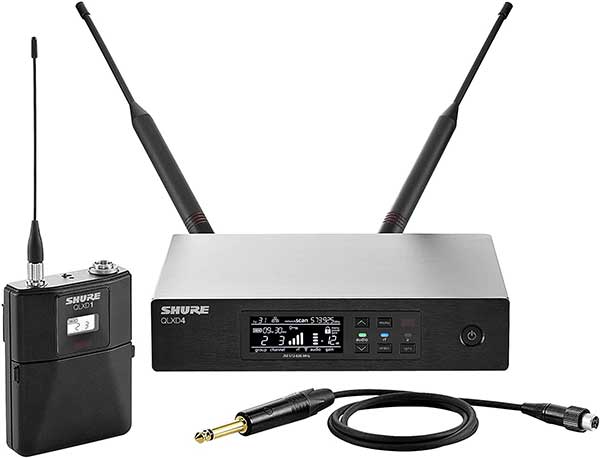
| Estimated Price | $873 |
| Range | 300 feet |
| Battery Life | 9 hours |
My Review: Shure QLXD14 guitar wireless system features a completely streamlined operation, which makes it a perfect choice for performers who are used to performing in mid-sized events. It comes with great 24-bit digital audio, alongside very well RF spectrum usage, which gives this model the ability to offer you perfectly straight performance, without any interruptions. The device is easy to use, since it has a receiver that searches and finds frequencies that are open for use, and then it simply transfers them to the transmitter. All you need to do is press the button, and you are set to go. QLXD14 is compatible with a number of microphones and wireless guitars, especially with Shure lavalier and head-worn microphones, which makes this device quite flexible. Its bodypack system is durable, and simple to set up, and along with great digital audio, there is also AES-256 encryption, as well as a networked control option, to let you have complete control over your user experience. The only possible downside of this rig is its price, which is quite high, compared to most other wireless guitar systems.
Key Specs and Features: It comes with the AES 256-bit encryption, which ensures that your transmission is completely safe, while the dynamic range of more than 120dB, which is capable of providing ample headroom. Menus are simple to navigate through, thanks to the LCD displays and LED meters for monitoring the audio and RF levels, as well as the strength of the signal. It can also be used on Mac, PC, and iOS devices, if you want a remote control, and there is a digital predicting switching, which is there to make sure that there is a solid RF connection, alongside easy setup with the one-touch sync option. This one offers a selectable display mode, which lets you see the frequency, how long the battery has been running, and the group/channel. Being simple to charge, with the external docking bays and the device has a rugged design, so the device is likely to last longer.
Build Materials: This Shure model has a specific rugged construction, made of top-quality ABS, in order to ensure maximum durability.
Hardware: It’s a digital system with the 470-534 MHz range of frequency, which allows up to 60 simultaneous systems per band. Nevertheless, it has a total operating range of 300 feet, while the frequency response is between 20Hz and 20kHz, and the channel selection is automatic. Transmitter has a bodypack form factor, alongside the mute feature, and one TA4M connector, as well as with the two AA batteries, which can last up to 9 hours straight. The receiver comes with two outputs: 1 x XLR, and 1 x 0.25”, LCD front panel display, and the detachable antenna.
Finish: QLXD14 model looks very dashing, due to its LCD display, LED indicators, and elegantly-shaped body, which simply makes it feel modern.
Who Will Use This the Most: Due to the price of QLXD14, it is probably best-suited for professional players, who usually have live performances of the medium size.
Bottom Line: Shure QLXD14 wireless guitar system is a pretty good, but also pretty costly choice, which is capable of delivering amazing audio quality, over medium distance.
9. Nady U-1100 GT
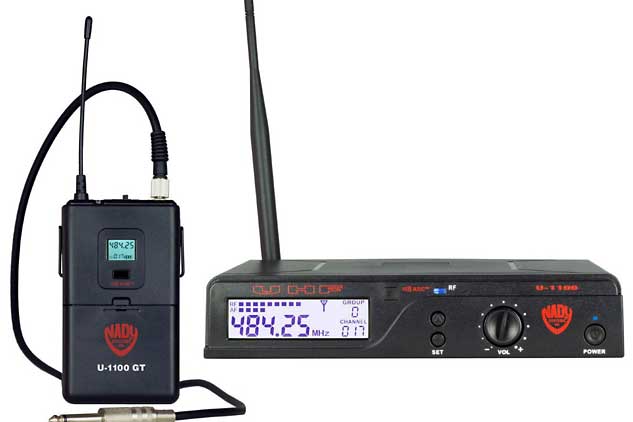
| Estimated Price | $120 |
| Range | 500 feet |
| Battery Life | 8-10 hours |
My Review: The U-1100 GT model from Nady is one of the professional UHF wireless systems this manufacturer offers to its customers. Nady is famous across the world for its excellent wireless technology, which allows you to have a really high-performance, as well as immense stability, while also being quite reliable. This model features one receiver capable of selecting 100 different UHF frequencies, which will let you customize your user experience the way you want. With the maximum effective working range of 500 feet (line of sight), you won’t have to worry about not having enough space to move around on the stage. Setting up this wireless guitar system is fairly easy since it has the ASC download that uses the infrared sender to connect to the transmitter and send the channel information to it. With everything in place, U-1100 GT wireless guitar system is capable of delivering crystal clear sound with minimal effort.
Key Specs and Features: It offers UHF PLL wireless performance, without the competition, which, due to the full frequency response, gives completely transparent tones. It is capable of maintaining high-quality sound up to 500 feet, while also featuring IF filtering when using several systems at the same time. The setup is as fast and simple as it gets with the ASC download and IR sender, and there is a frequency display, as well as buttons to select the set and adjust the volume.
Build Materials: Nady U-1100 GT features housing that is fully made of the ABS material of the highest quality, to ensure that the device has optimal durability.
Hardware: The system has a dynamic range of 120dB, while the operating range is a maximum of 500 feet. It has IF filtering for multiple connected devices at the same time. There is a 0.25” (3.5mm) cable included in the package.
Finish: The U-1100 GT model is well-crafted, with nice little details and coloring. It features the manufacturer’s logo on both transmitter and receiver, alongside the information for all the buttons, including the volume, set, and power.
Who Will Use This the Most: Nady U-1100 GT is great for everyone who wants to try out different frequencies, and find the perfect one for themselves, no matter whether they are professional musicians, or just casuals, who enjoy tweaking their sounds.
Bottom Line: Nady U-1100 GT is a well-made and reliable wireless guitar system, which is capable of letting you choose from a large number of frequency channels, at the maximum operating range of 500 feet, while also keeping the tonality clean and stable.
10. Sennheiser XSW-D Pedalboard Set

| Estimated Price | $350 |
| Range | 250 feet |
| Battery Life | 5 hours |
My Review: The Sennheiser XSW-D wireless guitar set features one-touch functionality, which makes sure that the device is completely simple to use. Alongside that, it comes with a 2.4GHz digital transmission that is compatible with multiple systems, allowing you to use systems from around the world without the need for any license. This model features a transmitter that is perfect for regular daily use, allowing you to move around, with an effective range of 250 feet. Along with that comes the battery that can last up to 5 hours of constant work, without having to recharge it. You can also connect it to a pedalboard receiver, and use its great tuner function, for delivering the optimal audio effect, alongside the very useful mute function for silent guitar transitions. Apart from that, this wireless guitar system looks pretty dashing and elegant, and it is also quite compact and easy to transport. It is also very simple to use, since it features a plug-and-play design, allowing it to have smooth and flexible operations.
Key Specs and Features: This one offers a compact pedalboard receiver, making it easy for transport and use, along with 2,400MHz of operating frequency, allowing you to use it worldwide. It comes with a digital wireless transmitter with a 6.3mm connector and Li-ion battery which can last up to 5 hours of continuous play. It’s so simple to use, due to the one-touch feature, and the maximum effective range of up to 250 feet. The tuner is quite convenient, allowing you to customize your tones the way you want them to be
Build Materials: XSW-D from Sennheiser is a very well-crafted wireless guitar system, made of ABS materials of the highest quality, allowing it to be durable, as well as light, and easy to transport.
Hardware: This is a completely digital system with up to 5 available simultaneous channels, with a frequency range of 2,400MHz across the 250 feet operating range, alongside automatic channel selection with a frequency response of 10Hz-18kHz. It has a simple plug-on transmitter with a rechargeable Li-ion battery, which can keep you going for 5 hours straight, and 1×1/4” cable connector. It has a pedal receiver-type, with one XLR, and one 1/4″ outputs, a front panel LCD display, a signal/noise ratio of 106dB, and with USB-C charging cable included in the package, alongside the 12V DC power supply.
Finish: This model from Sennheiser is pretty compact and well-designed, without sharp edges, covered with black ABS plastic, which, alongside small led indicators, makes it look very elegant.
Who Will Use This the Most: XSW-D is very easy to transport and set up, so it can be used by anyone, especially by those who need to travel to live performances often.
Bottom Line: Sennheiser XSW-D pedalboard set is a beautifully made wireless guitar set that is capable of delivering amazing sound quality, while not completely draining your wallet at the same time. It is also very simple to set up, which makes it quite popular amongst both professional and casual players.
11. Getaria GWS-8
| Estimated Price | $40 |
| Range | 100 feet |
| Battery Life | 8 hours |
My Review: Getaria GWS-8 wireless guitar system is a pretty cheap and reliable way to transmit the signal from your guitar. Since it is completely wireless, it allows you to avoid using annoying cables, and with a transmission range of a maximum of 30 meters, it will let you move around as well. Also, this model is very easy to use. All you need to do to start using it is to plug one unit into your guitar, while the other is plugged in the amp or pedal chain. After that, they will sync with each other, and you will be set to go. GWS-8 model features a dynamic range of 105dB, which, alongside the sampling of 24bit/48kHz, will grant you a completely clear sound with excellent tonality options. Apart from that, to improve the user experience, there is a 20Hz-20kHz frequency range, so you won’t experience any lags or sudden jumps in the sound. Truly, for this price, it is of great importance to say that GWS-8 from Getaria is a great choice, compared to some other wireless guitar systems in a similar price range.
Key Specs and Features: Operating distance is about 30 meters line of sight and 13 meters through the wall or other obstacles, and it features a head that can be rotated for 280 degrees. Simple plug-and-play design, allows you to set it up without any problems, with the LED indicator for the power, letting you see when the device is on. Being really light, weighing only 6.4 ounces makes it perfect for constant travel, and it also comes with the 1 CR2 battery, which is needed for running it, as well as with the USB charging cable. It allows the pairing of multiple devices at the same time, which you can read about in the user manual which is included in the package.
Build Materials: Just like most wireless guitar systems, this one is also completely made of ABS plastic of good quality, making it long-lasting and pretty, at the same time.
Hardware: It has a latency of just under 12ms, while THD and Noise are at the -98dB, and the dynamic range is higher than 105dB. The frequency response is in the interval of 20Hz-20kHz, with the +1dB/-3dB alongside the sample range is 24bit/48kHz, with the uncompressed digital transmission. The effective operating range is 30 meters (100 feet) in ideal conditions, and about 13 meters if there is a wall in between.
Finish: GWS-8 is nicely designed, with different colors for both transmitter and receiver. The transmitter is black, while the receiver is white. Also, every button is labeled, so you can know what you’re pressing, and at the bottom of both of these parts, there is a nice decorative line, which somehow looks like an anchor in the water, while the Getaria logo is right above it.
Who Will Use This the Most:
Being this cheap and simple to use makes GWS-8 a very popular choice amongst both casuals and professionals, who are looking for a relatively easy to use guitar system, which offers solid quality, without having to spend hundreds of dollars on it.
Bottom Line: That said, Getaria GWS-8 is a very affordable wireless guitar system, which is also quite good at transmitting beautiful tones at a relatively good distance.
12. LEKATO 5.8GHz Wireless Guitar System
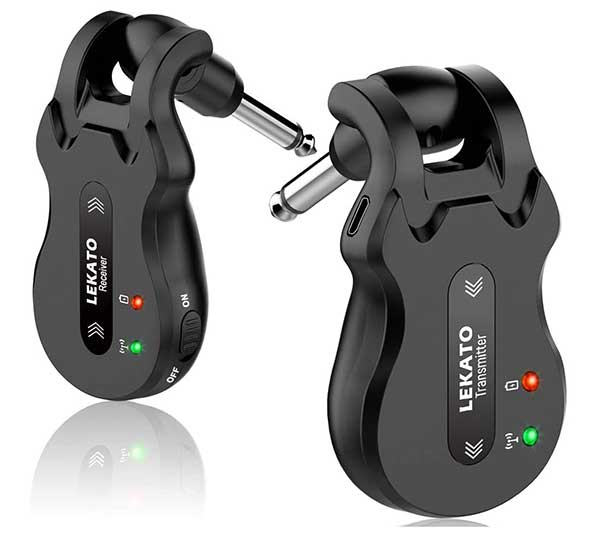
| Estimated Price | $63 |
| Range | 100 meters |
| Battery Life | 5 hours |
My Review: LEKATO wireless guitar system features excellent audio broadcasting quality, as well as the high-frequency ISM band, which makes this system great for wireless guitar systems that are licensed in Europe, Asia, South America, and Australia. To ensure that there is no external interference at all, this wireless guitar system comes with UHF technology, which means that it can muster high frequency with a low amount of latency, mostly 6ms, which allows it to transmit the guitar signal without any lag or dropouts. Along with that, the maximum working range of LEKATO wireless system is 100 meters, which is insane, and it means that you won’t have to worry about whether your movement on the stage will have a negative influence on the performance. Apart from that, you are able to simultaneously connect and transmit on the 4 channels. To ensure that it can last, there is a rechargeable lithium battery, with a maximum working time of 5 hours, before it has to be recharged again. Also, the device is fairly easy to use, since it features a simple plug-and-play design, along with the 220 degrees rotatable plug, allowing you to position it the way you see fit.
Key Specs and Features: It is a high-frequency wireless guitar system with the ISM Band, and 48kHz/24bit signal acquisition/playback, allowing you to experience top-quality audio. It has an amazing indoor range of more than 100 meters and the device allows simultaneous use of 4 different channels, while also having a 110dB dynamic range, for excellent tonality. The lithium battery can be recharged, allowing you to enjoy the music for 5 hours straight, completely without lag or dropouts, due to the low latency of 6ms. There is a USB cable, as well as the User Manual, included in the package.
Build Materials: LEKATO 5.8GHz wireless guitar system is completely made of top-rated ABS plastics, and it is kind of shaped like modern car keys. It is quite durable, and light, making it easier to carry it around.
Hardware: The input impedance of 220k and distortion level is less than 0.02%, while the frequency response is from 10Hz-22kHz, +1dB/-1dB. 46 channels in 4 channel banks, with a delay of under 6ms, as well as with the rechargeable lithium battery of 600mAh, which lasts for 5 hours sound like a great deal, right?
Finish: LEKATO wireless guitar system is beautifully-shaped, with very elegant curves and logotype in the middle, with the LED indicators for wireless and power underneath it.
Who Will Use This the Most: It’s one of the most affordable models out there, so it’s safe to say that almost everyone will use it at some point since it is capable of providing pretty good audio transmission. But, if you are looking for something more complex, with more available features, then you should look for another wireless guitar system.
Bottom Line: LEKATO Guitar Wireless System is a very affordable device, with all the basic functions you will need to successfully transmit your guitar’s sound. If you are looking for something like that, then look no further, but if you want something more complex, it would be better to find another guitar wireless system.
13. Getaria GWS-26
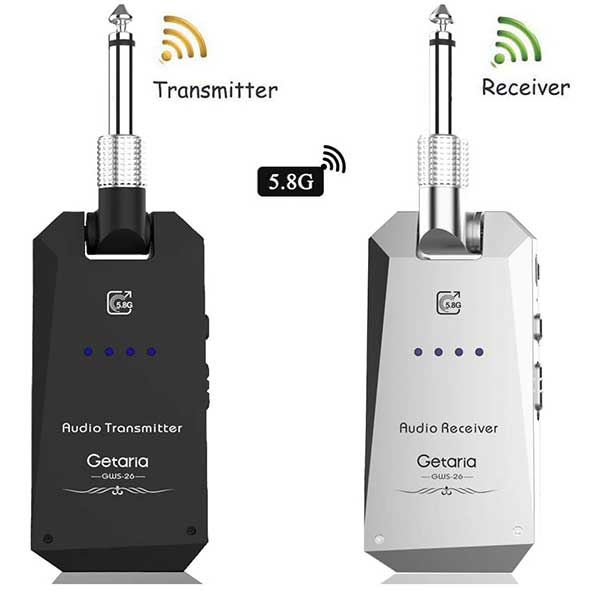
| Estimated Price | $65 |
| Range | 100 feet |
| Battery Life | 8 hours |
My Review: Getaria GWS-26 model delivers excellent uncompressed signal, which means that your tones will feel natural, without having to use the cable. Along with that, this model has a pretty good outdoor operating range of 100 feet, allowing you to move freely around the stage. The device itself is very easy to set up since you only need to plug and play it because there is no need for using any type of cable. That will make your user experience very flexible since the device is quite convenient. Also, you won’t have to fear occasional lags or dropouts, since GWS-26 features quite low latency of 5.6ms. Apart from that, multi-channel broadcasting is a thing, since you can do it on the 4 channels at the same time. Next to that is the ability to transmit the signal from a single transmitter to multiple receivers at the same time. Thanks to the pretty good technical specs, such as dynamic range, HQ audio broadcasting, and frequency response, this wireless guitar system can deliver a completely clean signal, without having to worry about declining sound quality. Due to the included lithium battery, you can play for 8 hours straight, with the ability for a fast recharge, where it only takes 1.5 hours to fully charge the device.
Key Specs and Features: It has a pretty good transmission range of 100 feet, allowing you to freely move around while playing, with a simple plug-and-play design, for fast setup. The best this is really low 5.6ms latency, ensuring that there are no disconnects or lags, which gives a clean signal and high-quality audio. Furthermore, it has a fast-charging rechargeable lithium battery, which can last up to 8 hours of constant work, and there are LED indicators for low power, which is useful if you forgot to charge the device. Finally, there is a rotatable 0.25” plug, so you could position it the way you see fit, which makes the device compatible with most types of guitars, as well as bass.
Build Materials: Getaria GWS-26 is built by using top-tier quality ABS materials, allowing it to be durable, as well as pretty at the same time.
Hardware: The dynamic range of 105dB while the frequency response is between 20Hz-22kHz, and there is an HQ audio broadcasting of 24bit/48kHz. It has ultra-low 5.6ms latency, as well as 0.25” connectors that can rotate for 190 degrees. The best part is its rechargeable lithium battery, working up to 8 hours without stopping, with the fast-charge technology, which needs only 1.5 hours to fully charge the device.
Finish: Transmitter and receiver have different colors, for easier recognition, one is black, while the other is white, just like with other Getaria models. In the middle, there are 4 LED indicators, which are showing how much life the battery has at the moment. And the shape of this device is very nice. It looks elegant and modern.
Who Will Use This the Most: This model is usable by everyone, but since it offers pretty basic features, at a very affordable price, it is the best choice for casual players, or for professionals who seek a simple, but effective wireless guitar system.
Bottom Line: Gestaria is known for offering good quality for a lower price, which is also the case with the GWS-26 wireless guitar system. It is capable of delivering pretty decent sound, while also being very simple to use, without too many extra features, that are usually not needed for the basic function of the device.
14. Nady DKW-3 GT
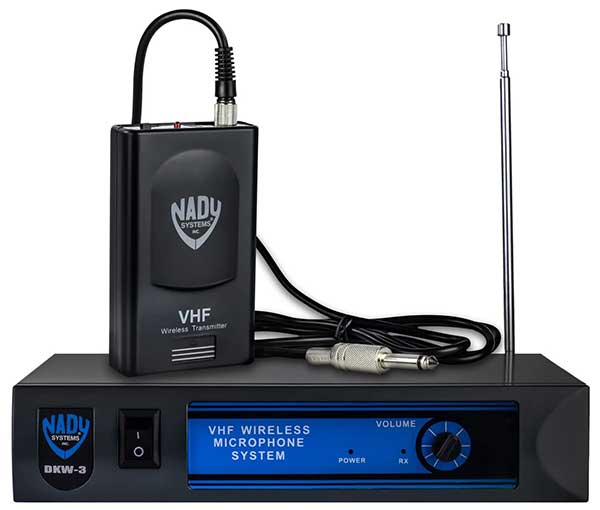
| Estimated Price | $60 |
| Range | 150 feet |
| Battery Life | 4-5 hours |
My Review: Nady DKW-3 GT comes with the DKW-3 receiver, as well as with the WGT Bodypack transmitter, which is both used for wireless performance. The device is capable of giving you almost the same audio quality as if you used the cable because of the VHF operation, which allows you to experience a completely reliable and performance without any lag or external interference. Along with that comes the excellent operating range this model offers, which allows you to move completely freely across the stage. Also, DKW-3 GT is quite easy to set up, since all you need to do is to plug it in the amp or audio mixer, as well as in your instrument. Because of the advanced audio processing circuitry, your tone output will remain stable, without too much noise, as well as without the annoying hissing sound when the instrument is idle. Apart from that, there is a front control panel, with the most important buttons, such as the ones for the power, and LED. When you’re turning the device on and off, the above-mentioned circuitry will prevent the device from causing the noise every time you turn it on and off.
Key Specs and Features: It’s the ideal system for beginners because it is simple to set up and use, thanks to the plug-and-play design, and the device provides great Hi-Fi audio. It has VHF (170-216 MHz) operations, that allow you to experience the device without any lags and external noise, with the advanced audio processing circuitry, which offers a pretty wide dynamic range, without any noise. There is a control panel for the most important buttons, while the antenna can be collapsed, and there is Audio muting available, with the Off/Standby/On buttons. And a pretty handy thing is an LED indicator that flashes once when the device is turned on, while lights stay on when the battery is at low levels and the device features a long operating range, allowing you to move around freely.
Build Materials: Like most other wireless guitar systems, Nady DKW-3 GT is also made of top-quality ABS plastics, allowing it to be smooth and durable for easier handling.
Hardware: This one has a frequency response of 80Hz-14kHz, +3dB/-3dB, and its dynamic range is 95dB, while total harmonic distortion is below 0.7%, which is great with the RF carrier frequency range of about 170-216MHz. There is a crystal controlled frequency stability of +-0.005%, and the modulation is FM(F3E), which is +-15kHz, across the operating range of 300 feet line of sight, and 150 feet otherwise. The battery is pretty good. It has a 9V battery at 120mA for the receiver, combined with the 38cm single collapsible antenna. Finally, it has a 3.5mm mono locking jack on the transmitter, as well as control panel buttons, and a 9V alkaline battery.
Finish: DKW-3GT has a very common square-like design, with a beautiful sky-blue panel, a darker body for the receiver, and a gray body for the transmitter, making the entire setup look very nice.
Who Will Use This the Most: Since it is not very expensive, this device is appealing to everyone, but it is the most suited for entry-level users since it is quite simple to use, while it still offers several additional features. Due to the long transmission range, it is also very common to be seen in the hands of professional performers, as well.
Bottom Line: Nady DKW-3 GT is a pretty solid guitar wireless system that is relatively easy to use, and it offers quite decent performance, without too much trouble.
Choosing the Right Wireless Guitar System (Buying Guide)
Before we move on to the best wireless guitar systems on the market, let’s learn something about the guitar systems as well, starting with the basic difference between the wired and wireless guitar systems. After that, I’m going to talk about how does wireless guitar systems work, what are the benefits of using them, and what are the most important things you should look for when buying the best wireless guitar system.
Wireless vs Wired Guitar Systems
When it comes to the choice between wired and wireless guitar systems, there are a lot of differences in people’s opinions, mostly depending on their personal preferences. Most differences are in the field of how well the signal flows, and how does that affects the general performance.
Wired Guitar Systems
Wired guitar system uses a cable connection to the amplifier in order to improve the sound effects, and boost up the audio you transmit via your guitar. A real problem here is to find cables made of top-quality materials, which is not always easy. You should consider these factors when doing it:
- Screening
- Capacitance
- Connectors
Those who used the poor-quality cables know that they tend to produce a really annoying buzzing sound, which is happening because those cables have really bad outside shelling. This doesn’t happen with high-quality cables because they have better protection from electrical interference for their conductors. Next, capacitance refers to the cable’s capacity to store an electric charge. Shorter cables will perform better with musical instruments. The longer the cable is, the harder it is for it to keep the best performance.
Last, but not least, the material used for connectors is also important. For instance, connectors with gold plating can perform better because their connectivity will be on a higher level than usual. These three factors combined to make a good cable for best-wired guitar systems, which can sometimes be quite annoying to find.
Wireless Guitar Systems
Wireless guitar systems are different because they eliminate the need for finding top-quality cables, in order to have a good connection. However, they are also not flawless. To be able to perform well, you need to find a high-quality wireless guitar system, otherwise, your performance might be even worse. There are two types of wireless guitar systems, analog and digital, about which I will talk about a bit later.
What you need to know is that to use some wireless guitar systems, you might need to get a license. Analog wireless guitar systems use UHF, or in other words, Ultra High-Frequency spectrum, which is also known under the name of Channel 38. To use analog devices, you will need to pay for the license, which costs around $90 on a yearly basis, and with that license, you can use multiple systems in that same channel. On the other hand, digital wireless systems use a wireless band to function, meaning that you won’t have to pay a dime to use them. Except for buying them of course. Now, for the question of which is better, wired or wireless, there is simply no answer to that, since both systems can yield high-quality results, depending on your choices, whether you were ready to pay a bit more to get a device made of high-quality parts or not.
How Wireless Guitar Systems Work
Wireless tech is applied everywhere nowadays, which also includes the world of music. Just like in all other fields, wireless in music also works the same way. There are two devices, a transmitter, and a receiver. The first one is used on the instrument itself, and it has a task to transform the signal sent from the instrument, which is analog, by the way, into the digital signal, which is further sent to the other device, called the receiver.
Once the receiver gets the signal, it has to transform that digital signal back to the analog and deliver it to the amplifier. This is just a simple explanation of how the process works. In order to fully understand what is happening, let’s talk about radio frequencies. A lot of devices use radio frequencies to connect and communicate with each other. We, humans, cannot see that, of course, but it is still happening.
That said, guitar wireless systems use these radio frequencies, more precisely, most of the time, they use Ultra High Frequency (UHF) and another type of frequencies called Very High Frequency (VHF). Both of these frequencies further use Frequency Modulation (FM).
Right now, UHF is a better choice, since it is more stable, and its flow feels more natural, but that can always change. One really important thing to know is that both of these frequencies work differently, and thus, offer different features. That means that you cannot claim that one is better than the other because they can both perform better in different environments. However, more importantly for our topic here is that the flexibility of the given frequency is one of the crucial aspects to consider here. For instance, if you use a wireless guitar system that has a fixed frequency, then it will probably perform terribly at some point, and you might even experience sudden noise spikes and dropouts.
That can happen because there might be multiple devices that are using the same frequency, like for instance, when you are near the TV and your phone begins to ring, you can hear that weird noise right? Or am I just too old to remember that? In any case, the same happens with guitar systems. And if you have more disturbances, then it will affect your performance a lot. Therefore, when looking for the best wireless guitar system, you should look for those that are capable of switching frequencies. They are a bit more expensive, but you will be much safer during live performance. However, most of the guitar wireless systems nowadays are capable of doing this automatically, which means that they will always try to use the least busy frequency, thus minimizing the chance of getting interferences.
Analog vs Digital Wireless Guitar System
On the market, you can find both analog and digital wireless guitar systems. But, how will you know what each of them offers? Let’s find out! The analog systems do the same thing we had talked about earlier, with one slight difference. They move the signal from one place to another, more precisely from the transmitter to the receiver.
However, before they do that, they need to use frequency modulation to compress that signal. Only then it will be sent to its path. Once that modified signal reaches the receiver, it goes further to the amplifier. This entire process is known by the name of companding, or companion. Without this process, it would be impossible to have a decent performance because the SNR, or otherwise known as signal-to-noise ratio, would be very low, and useless. More precisely speaking, SNR is tasked with describing whether the sound we want to hear is present in a recording or live performance, compared to the noise we don’t want to hear.
So, the overall effect of analog wireless systems is that in order to transfer the signal, they must compress it first, which can cause a decrease of the original sound quality. As for the digital systems, they also have the same task to move the signal from transmitter to receiver, but they work differently because they don’t have to compress the signal before moving it. Instead, they transform the analog signal from the transmitter to digital and then move it to the receiver, which turns it back into analog and sends it to the amplifier. This ensures that the chances of degradation of the sound quality are kept to a minimum, in order to keep the natural sound.
Why You Should Use Wireless Guitar System
Now that we have a good idea of how does the wireless guitar system work, let’s talk about the benefits it offers, and list some of the most important reasons why you should use the wireless guitar system.
1. Freedom to Move
One of the most obvious benefits of wireless guitar systems is that, when using it, you have much more freedom to move around the stage. Even though some wired systems use high-quality cables that don’t lose as much sound quality as others, it is still very important to keep the cable size to a minimum. Why? Because the longer the cable is, the harder it is for the device to accurately transform the sound, so it would sound more natural.
Therefore, a lot of professionals tend to use shorter cables, so they wouldn’t lose the quality of the audio effects. However, in that case, their movement is quite limited because of the cable reach.
This is not a small problem, especially if you are a performer with a pretty high spirit, who likes to move around and interact with your public.
Another problem with this is that you can trip over the cable and fall. A large number of players tend to wrap the cable around the belt of the guitar. This tactic ensures that the cable doesn’t break the connection and stay plugged in, but because of this, you will need to be extra careful about how you move, or you might trip on it and fall over, which might cause serious injuries.
2. Boosts the Sound Effect for the Entire Band
Usually setting up amplifiers goes to a certain point when you and the audience are completely satisfied with the setup. To check what the effects are in the end, most performers tend to get down where the audience is, while still playing the instrument.
Then, they take a walk around the place and see whether everyone is able to hear the music properly and clearly. If not, then they can simply tune up the sound, and make it better for everyone. This simply wouldn’t be possible without the wireless guitar system.
Just imagine trying to do it with the wired system. You would need like 100s of meters for cable, and it could still cause some harm both to you or your audience, which is definitely not what you want to get. Of course, not all wireless systems can allow you to do this as well. To be able to walk this much, you need to get a proper system with a long operating range. These types of wireless guitar systems are more expensive, but they are usually also of higher quality, which is why they are worth investing in.
3. Wireless Audio Quality Is Rising
When you look at the present trends for wireless guitar systems, you will see that their quality has constantly been improving over the course of the last couple of years. Even though some experts say that wired systems are still superior, it might not stay like this for much longer.
Because of this constant growth, and the continuous development of the new technology, as well as because of improvements made in the wireless tech itself, all predictions are that guitar wireless systems will soon overcome the wired systems, and most likely become much better. Therefore, investing in wireless guitar systems might be a good idea, if not now, then definitely in the close future.
4. Avoiding Accidents
Now, you might think I am joking, but a number of performers had been electrocuted on the stage in the past, and some were even in grave danger. The most famous of them was Keith Richards. He accidentally touched the mic stand with his guitar, which ended up badly for him. He basically flew backward, as people who were there had witnessed, and the blue sparks appeared where he stood.
Luckily for him, he was just unconscious for some time, and there weren’t any other serious injuries from the incident. This type of accident is very rare, and doesn’t occur so often. Most of the time people who are in charge of setting up the stage make sure that it is completely safe, by doing the grounding work. However, just like with everything in life, you cannot control all variables, and sadly, accidents like this can happen. When using wireless guitar systems, this is simply not possible, since there is nothing that physically connects your instrument to the amplifier and other objects on the stage.
The Most Important Features to Look for in Wireless Guitar Systems
Let’s take a look at what are some of the most important features you should look for when buying a wireless guitar system. There are a lot of available options on the market, and depending on your needs and budget, you will have to select the best ones for yourself. Without the knowledge of the features, you won’t even know what to look for, so without further due, let’s start!
1. Option to automatically switch the frequency
As stated above, the ability to switch between different frequencies is very important for all guitar systems because it reduces the chance to get disconnected and lags. If your frequency is getting busier, and at one point it gets too busy, your sound quality would suffer the consequences, which is why you should always look for a feature called ‘Automatic Frequency Selection’, or something similar to that.
2. Transmission distance
Now, in order to be able to move across the stage a lot, you need to have enough range, so you wouldn’t lose a wireless signal. If you perform in smaller places, where there is no need to move around during the performance, then you don’t need to look for a guitar wireless system with a long operating range. However, if that is not the case, you should always try to get as much range as possible, but also consider other factors as well.
3. Battery type and life
Battery life is very important, especially in long performances, where you need to play for a long time without stopping. Most batteries will offer you at least 5 or 6 hours of continuous play, which should be enough for smaller performances, but you should always aim for better, if you can afford it, of course. Also, a large number of wireless guitar systems nowadays come with Lithium-ion batteries that are completely rechargeable. Apart from that, some of them also include a fast-charging feature, allowing you to fully recharge them in an insanely short amount of time.
4. Latency
I am sure you wouldn’t want to experience any lags or dropouts, which is why latency is quite important. The lower it is, the situation is better for you. Always try to look for devices with at least less than 6ms latency.
5. Durability
If you’re using pedal-based wireless systems, then durability is quite important, since you will be stepping on the system quite often. Because of all that stomping, it can weaken, and eventually break, which is what you are trying to avoid in the first place. Therefore, always try to look for a system made of high-quality ABS materials that are compact and not easily broken.
6. Ease of use
Last, but not least, some guitar systems can be quite complicated to set up. If you’re a beginner, this can be pretty tiring. However, there are a lot of wireless guitar systems that have a plug-and-play design, which is very simple to use, since all you need to do is plug the receiver and transmitter and you are good to go.

My name is Chris and I’ve had a passion for music and guitars for as long as I can remember. I started this website with some of my friends who are musicians, music teachers, gear heads, and music enthusiasts so we could provide high-quality guitar and music-related content.
I’ve been playing guitar since I was 13 years old and am an avid collector. Amps, pedals, guitars, bass, drums, microphones, studio, and recording gear, I love it all.
I was born and raised in Western Pennsylvania. My background is in Electrical Engineering, earning a Bachelor’s degree from Youngstown State University. With my engineering experience, I’ve developed as a designer of guitar amplifiers and effects. A true passion of mine, I’ve designed, built, and repaired a wide range of guitar amps and electronics. Here at the Guitar Lobby, our aim is to share our passion for Music and gear with the rest of the music community.

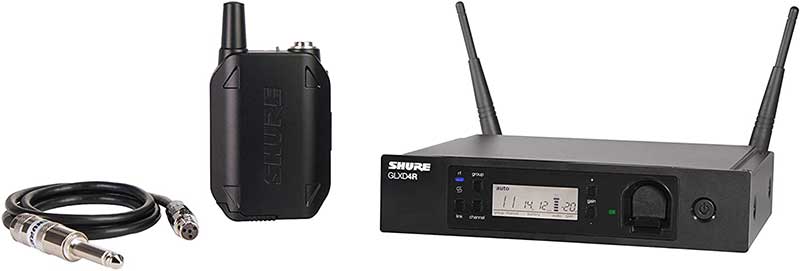
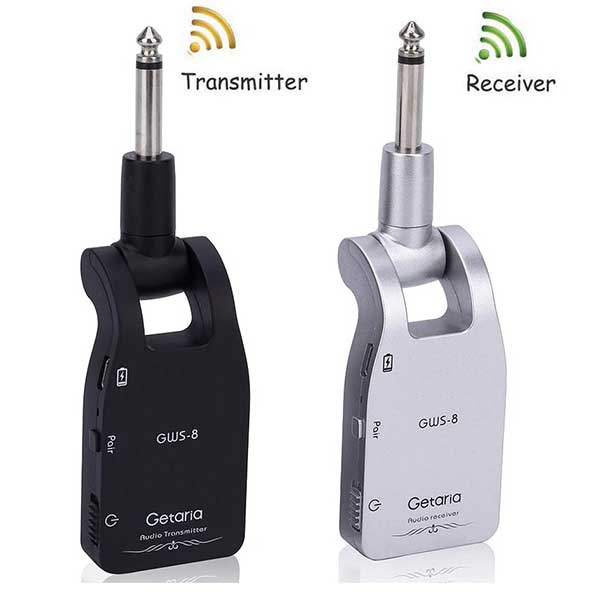
Great coverage of material! Well thought thru and presented from the many different aspects and expectations of a user. I am currently looking to replace a system that I bought but, can’t stand it because of the long latency of the product (contrary to what the product’s literature stated). And graciuosly enough, you have presented the reasonable latency requirement (approximately 6ms or less) for this type of device and is consistent with the better, albiet more expensive but, worth it devices.
Thank you much!!
Mike